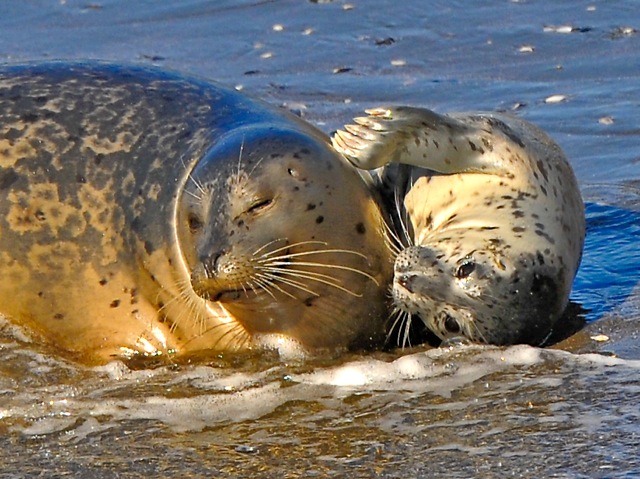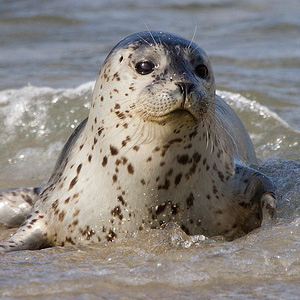Harbor Seal Taxonomy
- Order: Carnivora
- Family: Phocidae
- Genus: Phoca
- Species: vitulina
- Status: Protected under the Marine Mammal Protection Act
- Off our coast: year round
Description
Harbor seals are part of the “true seal” family, Phocidae. True seals lack external ear flaps, but their external ear canal is visible on the side of their head behind their large eyes. Harbor Seal are small, spotted seals, and can be dark with light spots or light with dark spots. Some harbor seals are fully or partially reddish in color, possibly caused by an accumulation of trace elements such as iron or selenium in the ocean, or a change in the hair follicles. They have short forelimbs that result in limited locomotion on land. Harbor Seals can reach a length of 6 feet and weigh up to 300 lbs. Males are slightly larger than females. They are the most common pinniped in California.

Behavior
Harbor Seals of the North Pacific are found Alaska to Baja California and are considered to be non-migratory. They favor nearshore coastal waters, and often haul out on rocky islets and mudflats in estuaries. Occasionally they haul out on sandy beaches and tend to rest with head and flippers elevated, in a banana like shape!
Harbor Seals feed in the water column or near the bottom, primarily in nearshore habitats. Their diet includes schooling fish, shellfish, and crustaceans and occasionally skates and rays. They often bring their prey to the surface, attracting gulls to clean up the left-overs.
Breeding

Harbor Seals mate at sea along the Mendocino coast and after a nine month gestation period, give birth on land between April and May to a single pup. Weighing around 20-25 lbs at birth, these pups are capable of swimming and even going underwater within a few minutes after being born. A pup will sometimes ride on its mother’s back when tired and makes a bleating noise that sounds like “maaaa.” Females nurse the pup for about 1 month. When the pups are weaned, the female is ready to mate again. Males defend underwater territories at sites near the pupping colonies.
While nursing, the females will occasionally leave the pup on land for a few hours while they go off to feed. Although well meaning beach goers sometimes assume the pups have been abandoned and try to help by putting them back in the water, covering them with a blanket, etc. it is important not to approach small pups on the beach. Always remember to stay at least 150 feet away from any marine mammal that you encounter.
